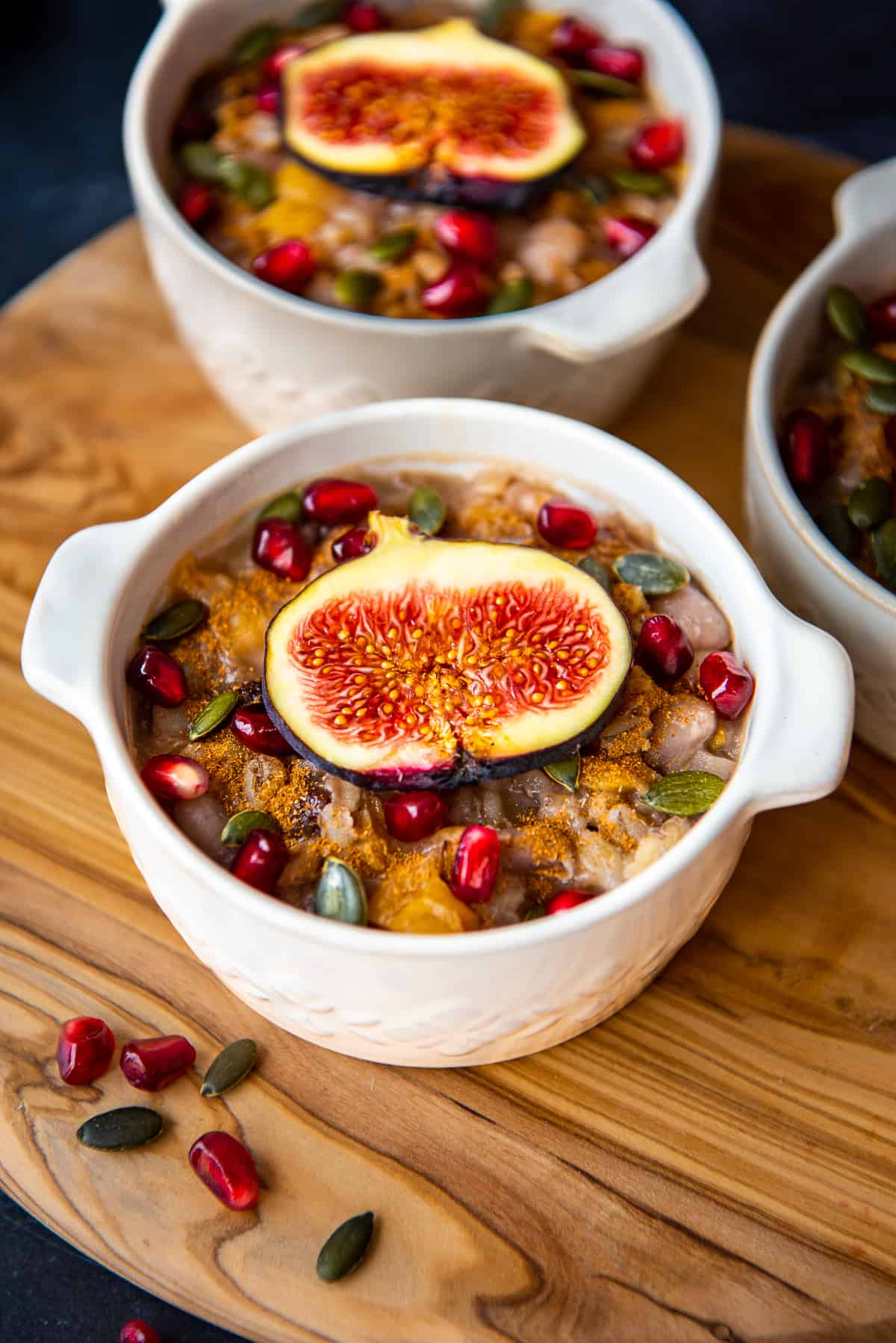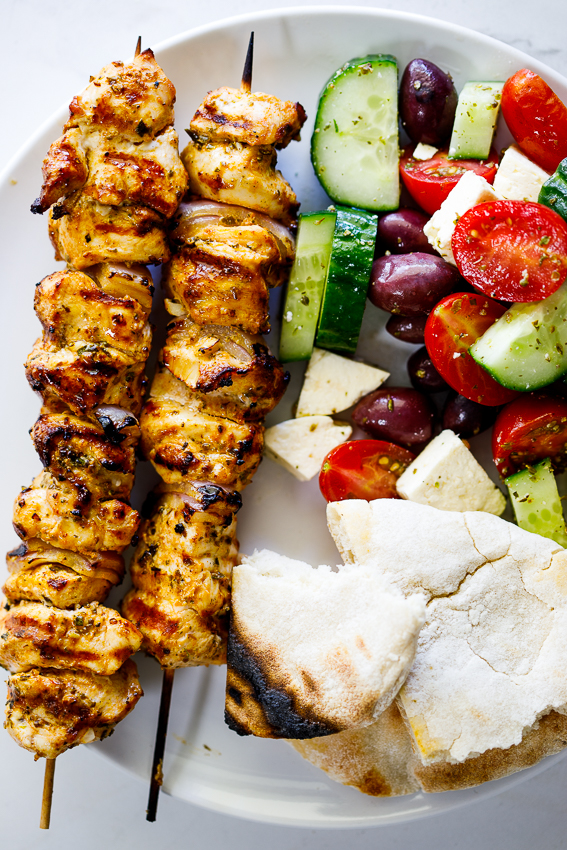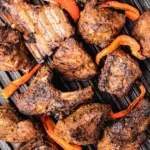When you explore Turkish cuisine, you’re not just discovering savory dishes but also a treasure trove of delightful desserts. Turkish desserts are a blend of rich flavors, textures, and aromas that reflect the country’s diverse cultural heritage.
Why are Turkish desserts cherished by so many? From the crispy layers of baklava to the creamy, unique delights like tavuk göğsü, each dessert offers a taste of history and tradition. Whether you have a sweet tooth or a curiosity for new flavors, Turkish desserts promise a memorable culinary experience.
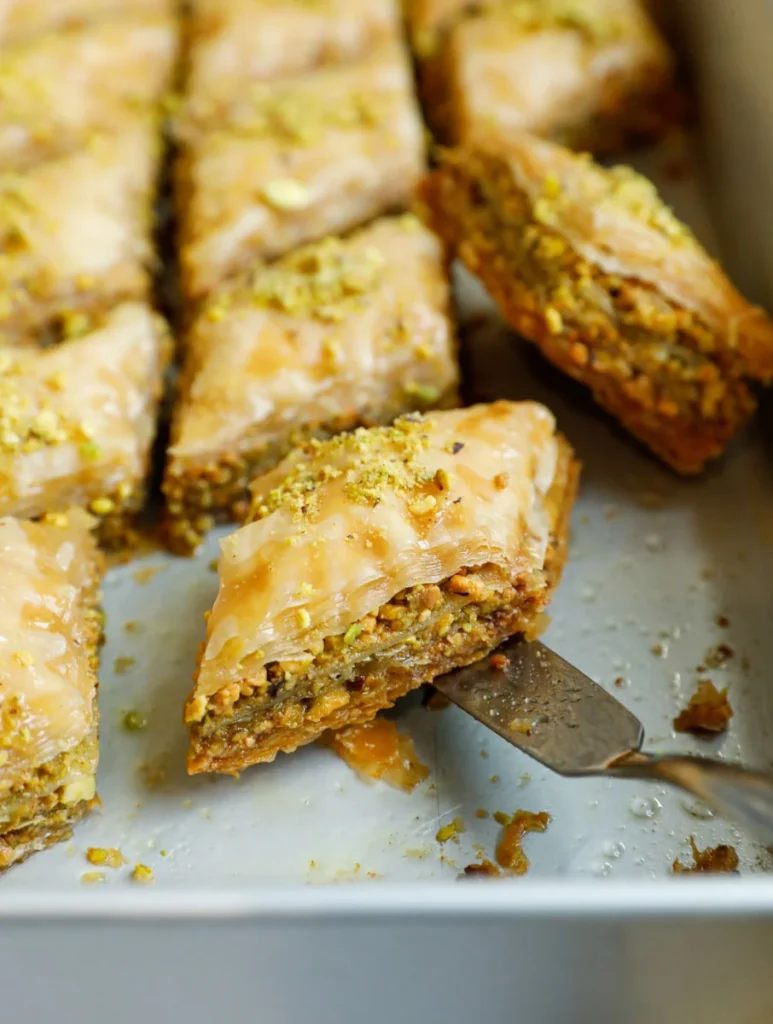
1) Baklava
Baklava is one of the most famous Turkish desserts. It’s made with layers of thin phyllo dough, which are brushed with melted butter and filled with chopped nuts like walnuts or pistachios. Each layer is carefully stacked, making the dessert rich and flaky.
After the layers are assembled, baklava is baked at around 350°F until golden brown. While it’s still hot, a sweet syrup made from sugar, water, and sometimes honey is poured over it. This syrup seeps into the layers, giving baklava its signature sweetness and sticky texture.
Cut into diamond shapes, baklava is both crunchy and chewy. It’s often garnished with a sprinkle of ground nuts for an extra touch. This dessert is typically enjoyed with a cup of Turkish tea or coffee, balancing the sweet flavors perfectly.
Making baklava can be time-consuming due to the delicate phyllo layers, but the end result is worth the effort. Baklava is a treat that’s often served during special occasions and holidays, highlighting its importance in Turkish culture.
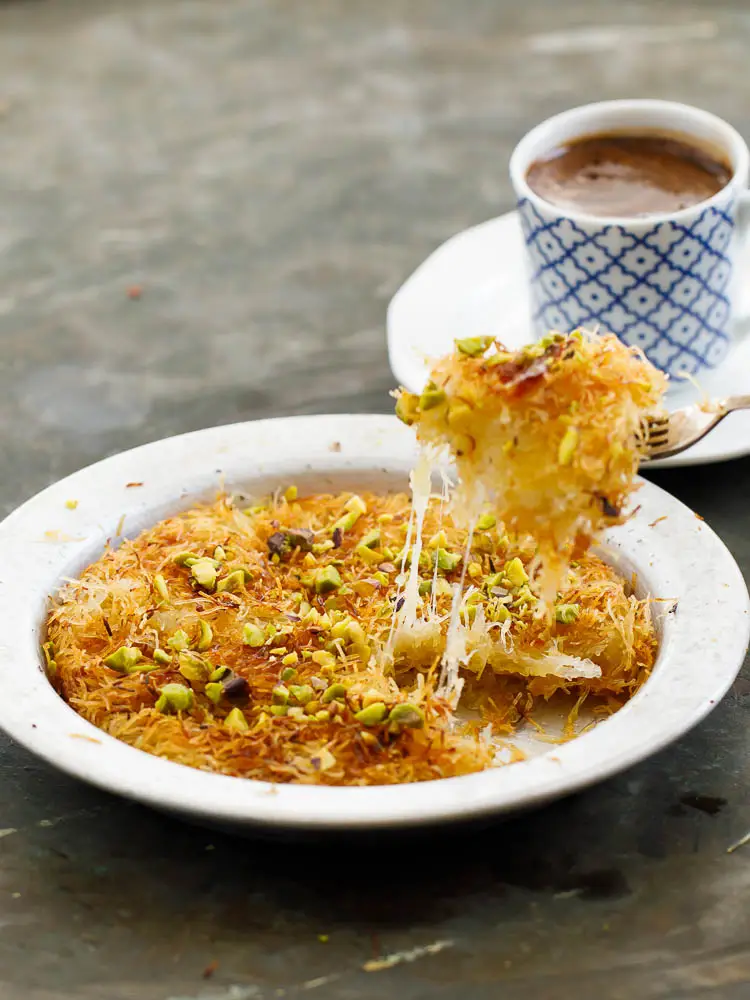
2) Künefe
Künefe is a beloved Turkish dessert made with thin, shredded dough called kadayıf and a special cheese filling. It is crispy on the outside and gooey on the inside.
You start by buttering a medium-sized frying pan and spreading half of the buttered kadayıf evenly. This creates the base layer. Next, add a layer of cheese, such as mozzarella or a traditional Turkish cheese like Hatay or Nabulsi.
Ensure the cheese layer stays away from the edges to prevent it from leaking. Cover with the remaining kadayıf, pressing it down gently to make it firm.
Cook the künefe over low heat until the bottom turns golden brown. Then, flip it carefully to cook the other side.
Prepare a simple syrup with sugar, water, and a touch of lemon juice. Once the künefe is cooked, pour the hot syrup over it.
Serve your künefe warm, garnished with crushed pistachios for an added crunch. Its combination of sweet, cheesy, and crispy textures makes it an unforgettable treat.
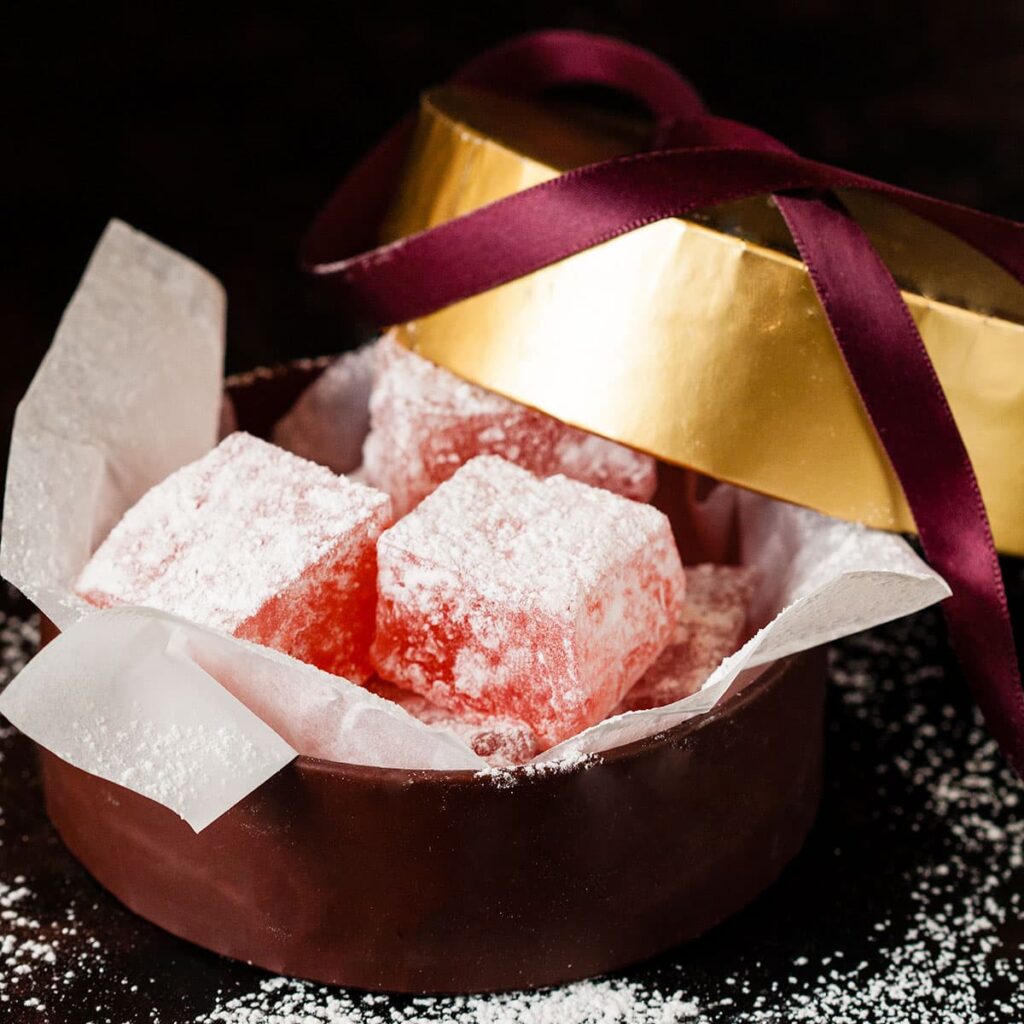
3) Lokum (Turkish Delight)
Lokum, commonly known as Turkish Delight, is a traditional Turkish dessert that dates back centuries. It is typically made from a gel of starch and sugar, often flavored with rose water, lemon, or other fruits and spices.
To prepare Turkish Delight, you first create a sugar syrup by combining sugar, water, and lemon juice. This mixture is heated until the sugar dissolves and the syrup thickens. Next, cornstarch is mixed with water and then whisked into the hot sugar syrup.
As the mixture continues to cook, it will gradually thicken. This is when you can add flavorings like rose water or vanilla. Once the desired consistency is reached, the mixture is poured into a dish to cool and set.
When the Lokum has firmed up, it is turned out onto a surface dusted with a mixture of powdered sugar and cornstarch. The finished product is then cut into bite-sized cubes and coated with more powdered sugar to prevent sticking.
Turkish Delight is known for its soft, chewy texture and delicate flavor, making it a favored treat for many.
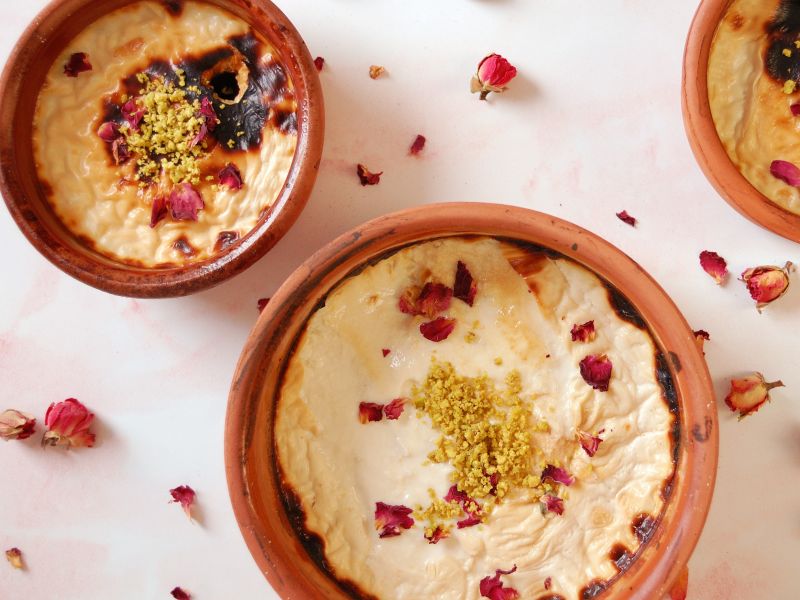
4) Sütlaç (Rice Pudding)
Sütlaç is a traditional Turkish dessert made from rice, milk, and sugar. It is a creamy and comforting dish that has been enjoyed for generations.
To make Sütlaç, you start by cooking rice in water until it’s soft. Then, you add in most of the milk and simmer until the rice is completely tender.
Once the rice is cooked, sugar and sometimes vanilla are mixed in for sweetness and flavor. You slowly bring the mixture to a gentle boil, stirring constantly to prevent it from sticking.
The thickness of Sütlaç is often achieved by adding cornstarch or wheat starch mixed with a bit of milk. This mixture is poured into the simmering pudding and cooked until thickened.
Some variations of Sütlaç are baked until the top is golden brown. This gives it a unique texture and flavor, making it even more delicious.
Sütlaç is typically served cold, and you can sprinkle cinnamon or crushed nuts on top for extra flavor. This dessert is perfect for a hot summer day or as a comforting treat during any season.
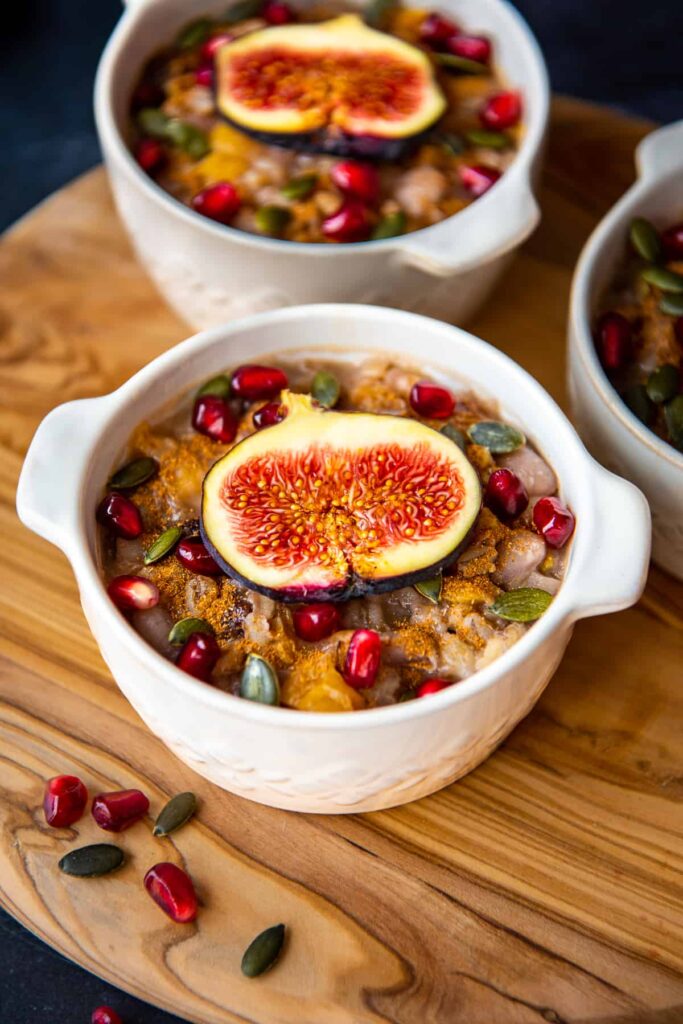
5) Aşure (Noah’s Pudding)
Aşure, or Noah’s Pudding, is a traditional Turkish dessert with a rich history. It is often considered one of the oldest desserts in the world.
This sweet dish is typically made with a variety of grains like barley and rice, and features a mix of dried fruits such as figs, apricots, and raisins.
Nuts like walnuts, hazelnuts, and pine nuts add both texture and flavor. Chickpeas and white kidney beans are also common ingredients.
Traditionally, Aşure is prepared during the month of Muharram in the Islamic calendar. The Day of Aşure falls on the tenth day of this month.
Making Aşure involves soaking the grains and beans overnight, then boiling them with the fruits and nuts until the mixture thickens into a pudding-like consistency.
Sometimes, rose water or citrus zest is added for extra aroma and flavor. This dessert is not only delicious but also symbolizes sharing and community, as it is often distributed to neighbors and friends.
Aşure is enjoyed by many across Turkey and in regions influenced by Ottoman cuisine. Its unique blend of ingredients makes it a versatile and nutritious dessert.
You can serve Aşure warm or cold, often garnished with pomegranate seeds or a sprinkle of cinnamon.
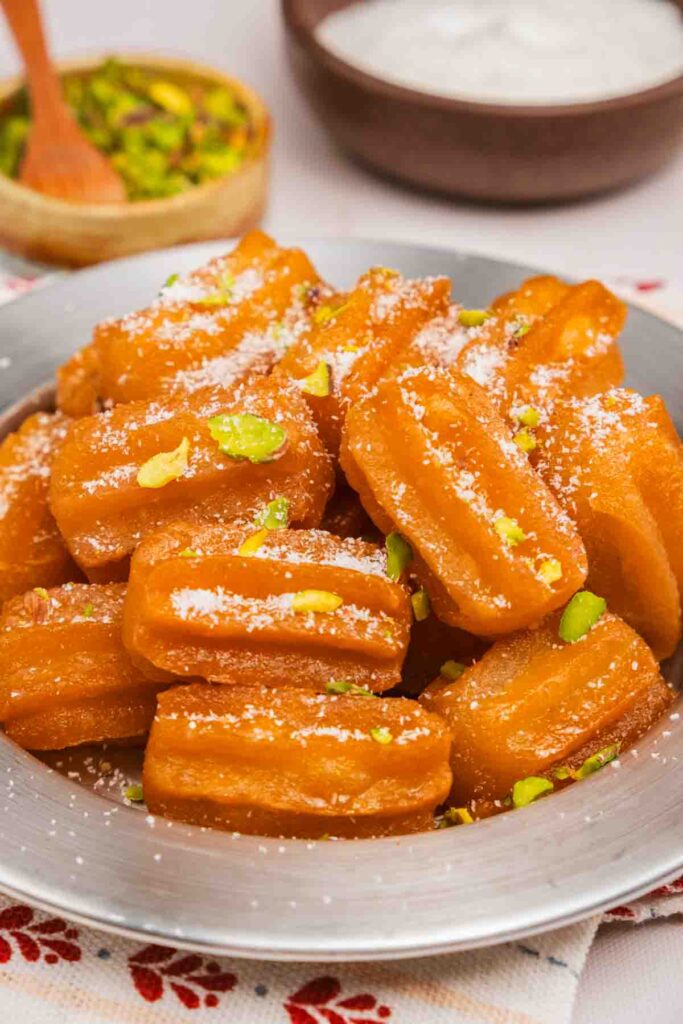
6) Tulumba
Tulumba is a popular Turkish dessert known for its sweet and crispy texture. It is often enjoyed during festive occasions and celebrations.
To make Tulumba, you start by preparing a simple syrup. Combine water, sugar, and lemon juice in a saucepan. Bring it to a boil, then let it simmer for about 15 minutes. Allow it to cool completely.
For the dough, you mix water and butter in a pot until the butter melts. Then, you stir in flour to form a smooth dough. Once the dough cools, you add eggs one at a time, mixing until the dough is sticky and smooth.
The dough is then put into a pastry bag with a star-shaped nozzle. You pipe the dough directly into hot oil, frying until the pieces are golden and crispy. After frying, the hot Tulumba is immediately soaked in the prepared syrup until fully saturated.
When done right, Tulumba is crunchy on the outside and soft on the inside. The syrup gives it a delightful sweetness, making it a favorite among Turkish sweets. Enjoying Tulumba is a treat for anyone who loves rich, sugary desserts.
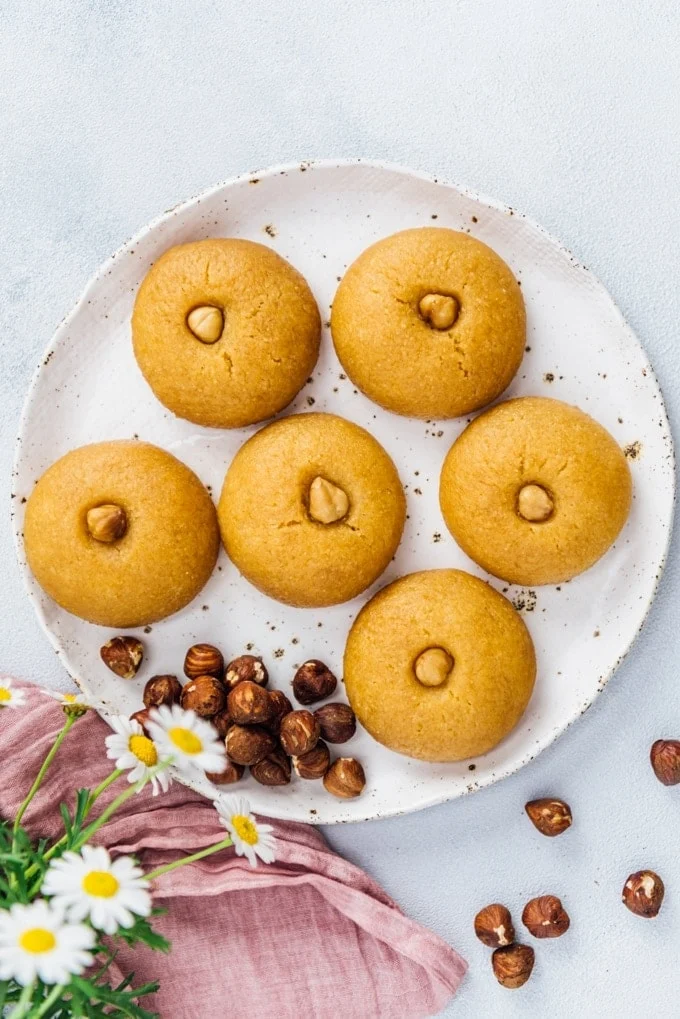
7) Şekerpare
Şekerpare is a traditional Turkish dessert made from semolina and flour, then soaked in syrup. These cookies are popular for their soft texture and sweet taste.
To make the dough, you need to mix flour, semolina, softened butter, eggs, icing sugar, vanilla paste, and baking powder. Mix these ingredients until they form a smooth, consistent dough.
Shape small portions of dough into oval balls. Place them on a baking tray, leaving space between each one. Brush the tops with egg yolk to give them a shiny finish.
While the cookies bake, make the syrup. Combine sugar and water in a saucepan and bring it to a boil. Add a bit of lemon juice for flavor and let it simmer until the sugar dissolves completely.
Once the cookies are baked, pour the warm syrup over them. Let the Şekerpare soak up the syrup until they become tender and juicy.
Serve these delightful cookies at room temperature. They are often enjoyed with a cup of Turkish tea or coffee.
Enjoy the sweet and moist flavors of Şekerpare, which perfectly represent Turkish dessert traditions.
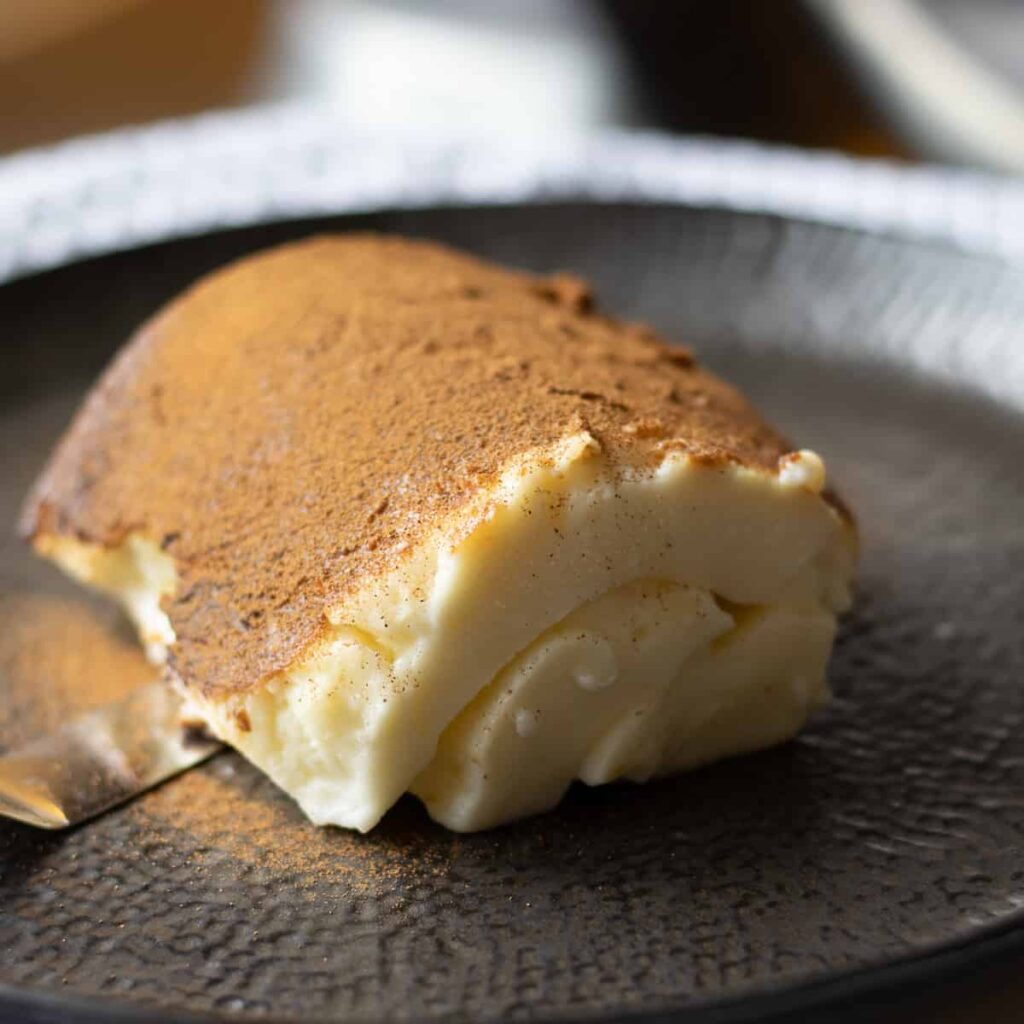
8) Kazandibi
Kazandibi is a traditional Turkish dessert known for its sweet, creamy texture and caramelized top. It’s often referred to as “burned bottom pudding” because of its distinctive caramelized layer.
To make Kazandibi, you start by heating milk, sugar, and cream in a pan until the sugar dissolves. Constantly stir to prevent it from sticking.
Once it thickens, pour the mixture into a large, flameproof pan. Place the pan over a medium-high burner and caramelize the bottom by rotating the pan. Be sure to use oven mitts to avoid burns.
After the bottom is evenly caramelized, let the dessert cool. Once cooled, cut it into slices. For a traditional presentation, you can roll each slice before serving.
Kazandibi combines a creamy interior with a crispy, caramelized surface, offering a unique texture and flavor. Enjoy it as a delightful end to any meal.
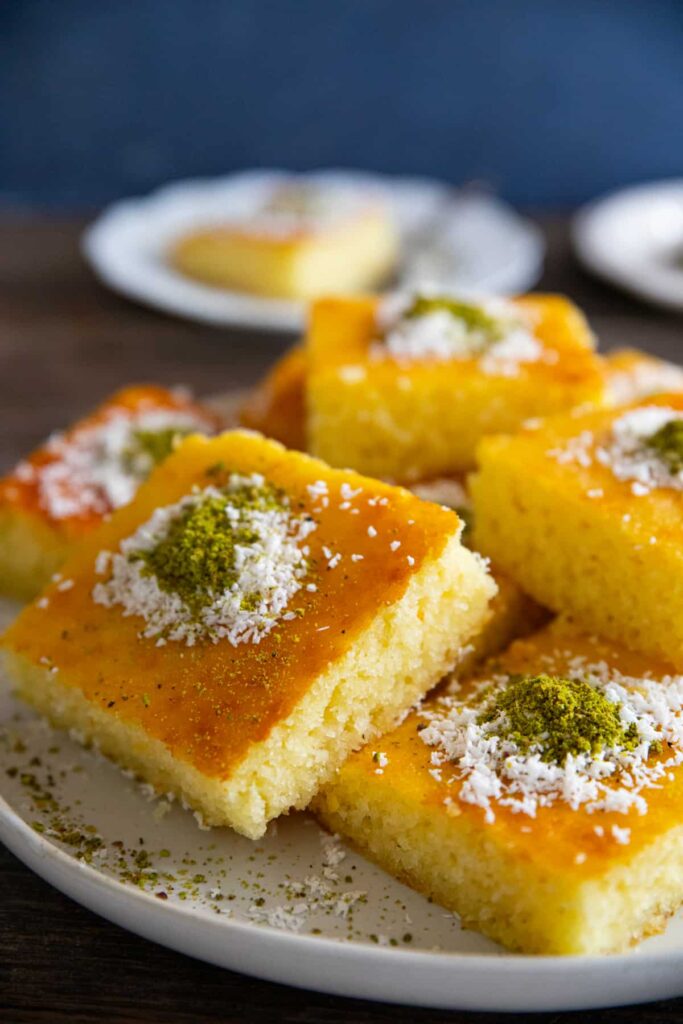
9) Revani
Revani is a classic Turkish dessert made from semolina flour and soaked in lemon syrup. This cake is light and sweet, making it a popular treat.
To make Revani, you start by preparing the syrup. Mix sugar and water in a saucepan, then bring it to a boil while stirring. Let the syrup cool down before using it.
Next, eggs and sugar are beaten together until light and fluffy. Yogurt, olive oil, and a bit of salt are whisked in. Dry ingredients like semolina flour, all-purpose flour, and baking powder are then added to the mixture.
Once mixed, pour the batter into a greased baking pan. Bake at 350°F for about 30 minutes. When the cake is done, pour the cooled syrup over the hot cake. Allow it to soak in completely.
Revani can be eaten warm or cold. It is often decorated with grated coconut or chopped nuts. This dessert is perfect for special occasions or as a sweet treat after a meal. It provides a delightful combination of textures and flavors, making it a standout among Turkish desserts.
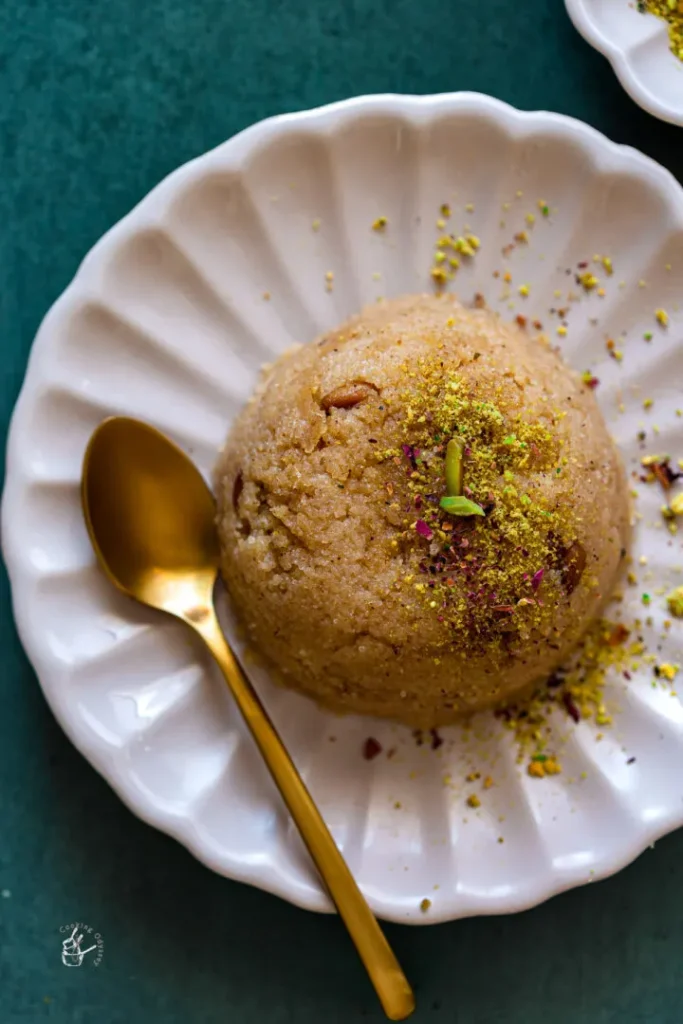
10) Helva
Helva is a beloved dessert in Turkish cuisine. It is known for its smooth, rich texture and sweet flavor. There are several types of Helva, with two of the most popular being Flour Helva and Semolina Helva.
Flour Helva is made using flour, butter, and sugar. The flour is cooked until it turns golden brown and releases a nutty aroma. This process gives Flour Helva its distinct taste and texture.
Semolina Helva, on the other hand, uses semolina instead of flour. The semolina is toasted in butter and then combined with a sweet syrup made from sugar, water, and sometimes milk. Pine nuts are often added for extra flavor and crunch.
Making Helva at home requires patience. The mixture must be stirred continuously to ensure it cooks evenly and achieves the right texture. Once prepared, Helva can be enjoyed warm or at room temperature.
Helva is not only a dessert but also a dish with cultural significance. It is commonly prepared during religious ceremonies and events. In Turkey, it’s traditional to serve Helva after funerals as a way to honor the deceased.
You can find Helva in many Turkish households and bakeries. It’s a treat that’s appreciated for both its taste and its cultural importance.
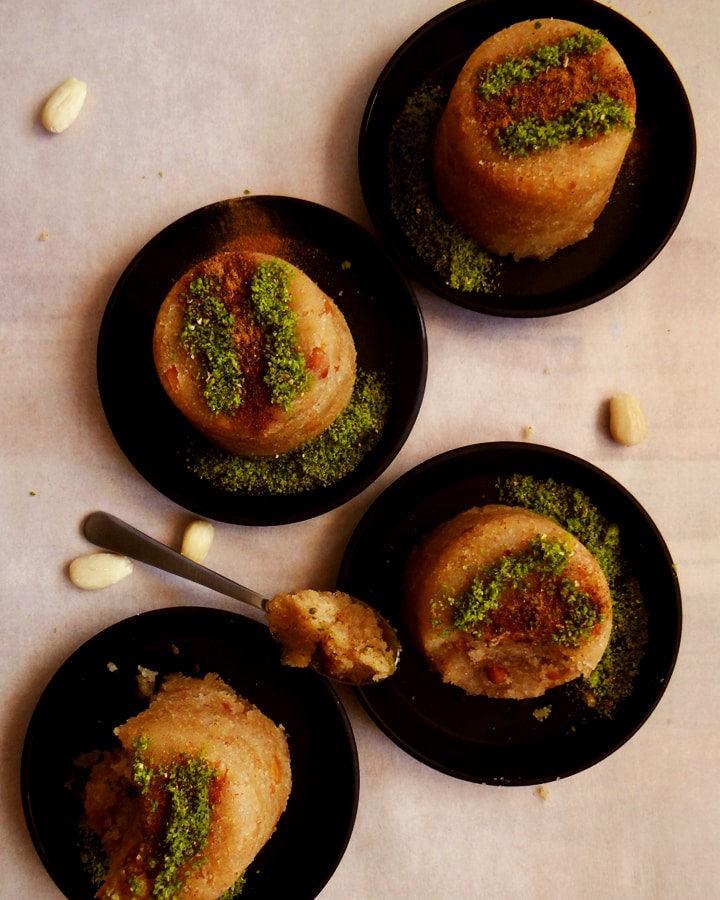
11) İrmik Helvası
İrmik Helvası is a popular Turkish dessert made from semolina. It is often served at special occasions and gatherings.
To make İrmik Helvası, you start by melting butter in a pan. Pine nuts are added to the butter and sautéed until golden brown. Then, semolina is stirred into the mixture and cooked until it takes on a golden color.
A syrup made from sugar, milk, and water is prepared separately. Once the semolina mixture is ready, the syrup is carefully poured over it. The mixture is then covered and cooked on low heat until it thickens.
Let the İrmik Helvası rest for about 15 minutes before serving. This allows the flavors to meld and the dessert to set. Serve warm or at room temperature. The pine nuts add a nice crunch, while the buttery semolina gives it a rich flavor.
Many people enjoy İrmik Helvası as a comforting and satisfying treat. You might find it served with a sprinkle of cinnamon or a scoop of ice cream.
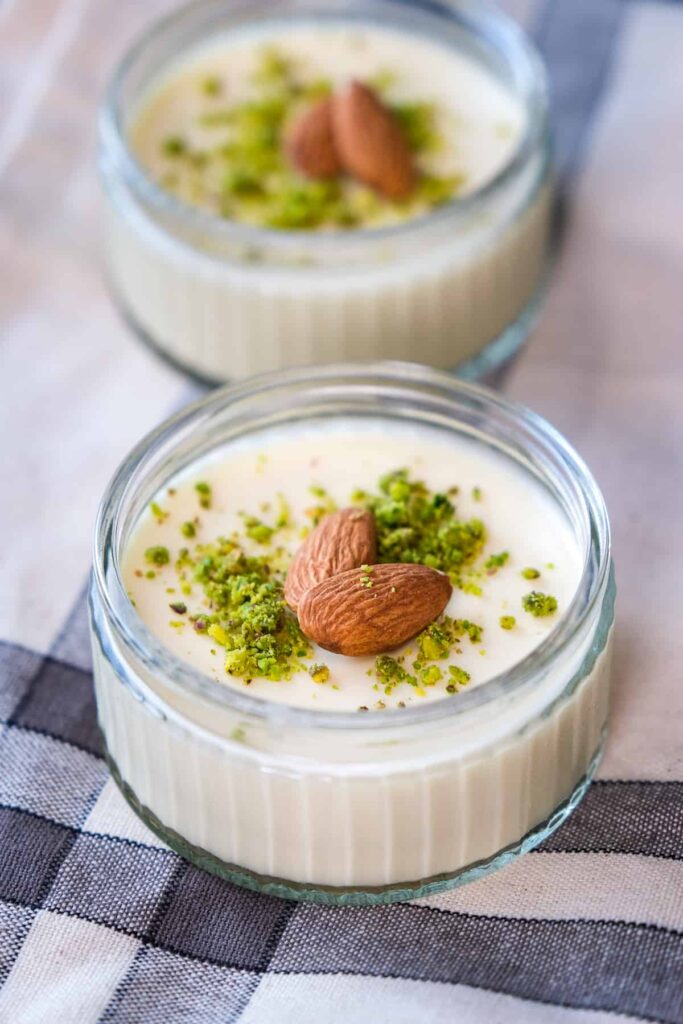
12) Keşkül
Keşkül is a traditional Turkish almond pudding that combines creamy texture with rich flavors. It stands out among Turkish desserts for its simplicity and delicious taste.
To prepare Keşkül, you mix egg yolk, sugar, rice flour, and cornstarch in a saucepan. Gradually add milk while stirring to achieve a smooth mixture. Incorporate ground almonds and desiccated coconut for added flavor.
Cook the mixture on low-medium heat, stirring constantly. Once it thickens, pour it into individual serving bowls or parfait glasses. Let it cool at room temperature before chilling in the refrigerator for at least three hours.
When ready to serve, garnish with coconut flakes, crushed pistachios, and an almond or two placed in the center. This not only adds to the visual appeal but also enhances the taste.
Keşkül is often enjoyed as a light and refreshing dessert, perfect after a heavy meal. Its creamy and nutty flavors make it a favorite among both locals and visitors in Turkey.

13) Zerde
Zerde is a traditional Turkish dessert made with rice, saffron, and rose water. This sweet treat is often prepared for special occasions and celebrations.
The key to making Zerde is in the saffron. Start by soaking saffron in rose water overnight. This allows the flavors to fully infuse.
Once the saffron is ready, cook rice with water until it is soft but not mushy. Add a mixture of dissolved cornstarch and more water to the rice. This helps to thicken the dessert.
Now, stir in sugar, pine nuts, currants, and the saffron-rose water mixture. Continue cooking on medium heat, stirring constantly, until the mixture sets.
Zerde’s distinctive golden color and unique flavor come from the saffron. The rose water adds a fragrant aroma. Serve Zerde chilled or at room temperature for a refreshing and flavorful dessert.
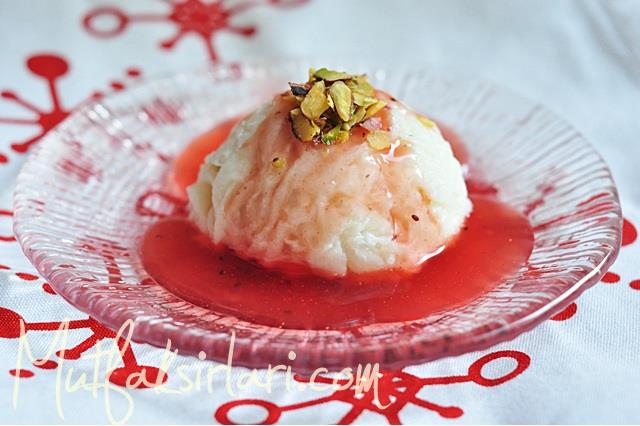
14) Güllaç
Güllaç is a special Turkish dessert often enjoyed during Ramadan. It’s made from thin cornstarch sheets soaked in rosewater-infused milk. The mixture creates a delicate and unique texture.
The sheets, known as güllaç leaves, are typically layered with nuts like walnuts, hazelnuts, or almonds. This adds a tasty crunch to each bite.
To make güllaç, you start by mixing flour, cornstarch, and water. The mixture is cooked in a frying pan to form thin sheets. These sheets are then soaked in sweetened milk.
The milk is usually flavored with rosewater for extra aroma and taste. Once the layers are assembled, güllaç is refrigerated to set and served cold. It’s a refreshing dessert, especially after a long fasting day.
You can easily find güllaç sheets in Turkish markets or online. Adjust the sugar to your taste if you prefer it less sweet. This dessert is a wonderful blend of textures with its tender sheets and crunchy nuts. Enjoy it as a light alternative to other sugary treats.
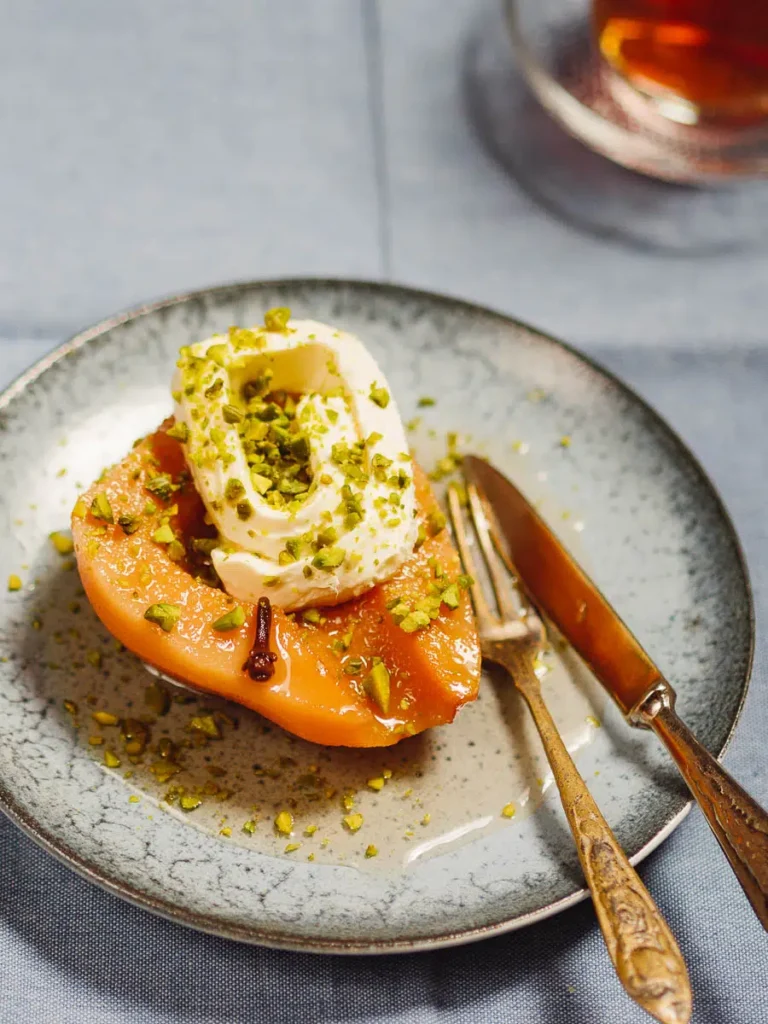
15) Ayva Tatlısı (Quince Dessert)
Ayva Tatlısı is a traditional Turkish quince dessert. It is known for its beautiful color and rich flavor. This dessert is made by cooking quince halves with sugar and spices, turning them into a soft, sweet treat.
To make this dessert, you start by peeling and halving the quince. Keep the seeds aside, as they help give the syrup a lovely red hue.
Place the quince halves in a pot. Add sugar, water, and the reserved seeds. You can also add cloves or cinnamon for extra flavor.
Bring the mixture to a boil, then reduce the heat. Let it simmer gently for an hour. The quinces should become tender and pink.
Serve Ayva Tatlısı with a dollop of Turkish thick cream, known as Kaymak, or clotted cream. You can also sprinkle crushed pistachios or walnuts on top. This adds a delightful crunch to the dessert.
Ayva Tatlısı is often enjoyed during the fall and winter seasons when quinces are in season. Its unique taste and beautiful presentation make it a popular choice for special occasions.
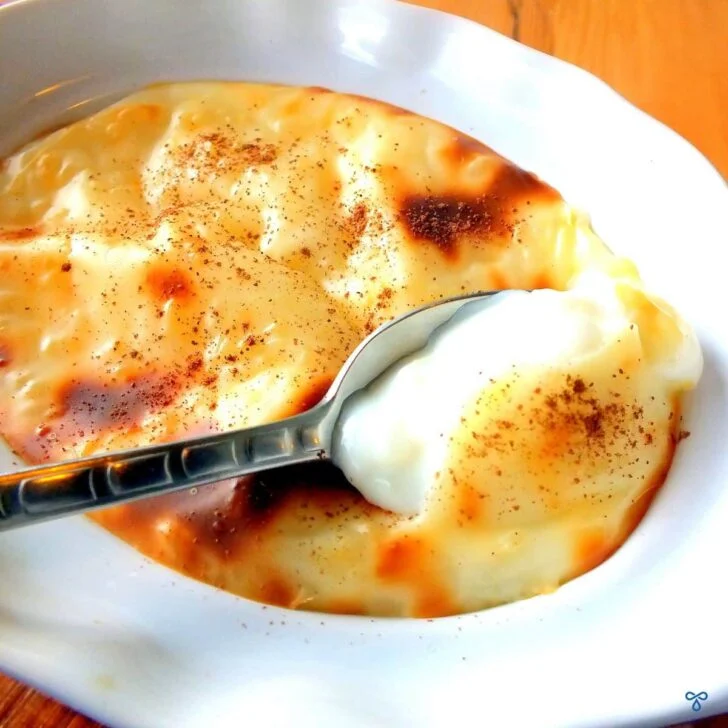
16) Fırında Sütlaç (Baked Rice Pudding)
Fırında Sütlaç, or Baked Rice Pudding, is a popular Turkish dessert. You start by rinsing the rice and cooking it in water until it softens. Once the rice cooks, you add milk and stir frequently to prevent sticking.
Mix some cornstarch with a bit of cold water. This helps thicken the pudding. Pour in the mixture and continue stirring on low heat until it thickens. Add sugar and vanilla, and cook for a few more minutes.
Divide the mixture into small, oven-proof ramekins. Place the ramekins in a deep oven tray filled with water. This water bath helps cook the pudding evenly. Bake the rice pudding at 350°F (180°C) until the tops are nicely browned.
The result is a creamy dessert with a caramelized top layer. It’s often enjoyed warm but can also be served chilled. This dessert is simple yet rich and comforting, making it a beloved treat in Turkey.
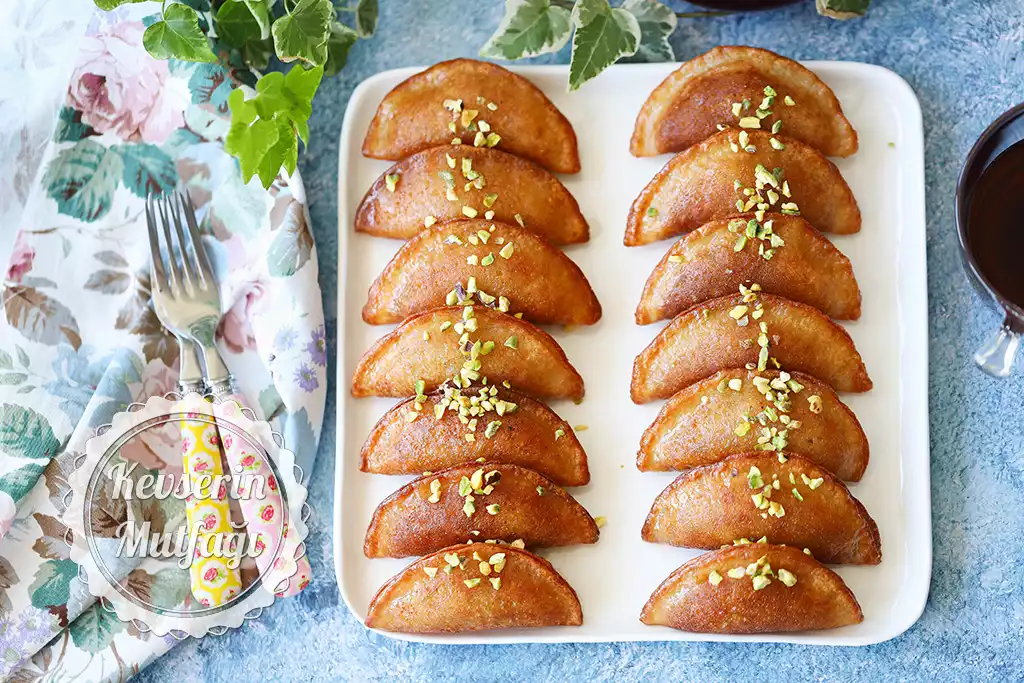
17) Taş Kadayıf
Taş Kadayıf is a popular Turkish dessert often enjoyed during Ramadan. It’s a fried pastry filled with a sweet mixture, commonly nuts like walnuts or pistachios.
To start, you make a simple syrup with water, sugar, and a bit of lemon juice. Boil until the sugar dissolves, then let it cool.
Prepare the batter using flour, water, and yeast. Pour the batter into small rounds, similar to making pancakes. Once cooked on one side, they are ready to be filled.
Fill each pastry with your choice of nuts or even a custard. Fold them into half-moon shapes and seal the edges tightly.
After filling, fry the pastries until they turn golden brown. Once done, soak them in the cooled syrup for a few minutes, allowing them to absorb the sweet liquid.
Serve Taş Kadayıf warm or at room temperature. This dessert delights with its crispy exterior and sweet, nutty filling.
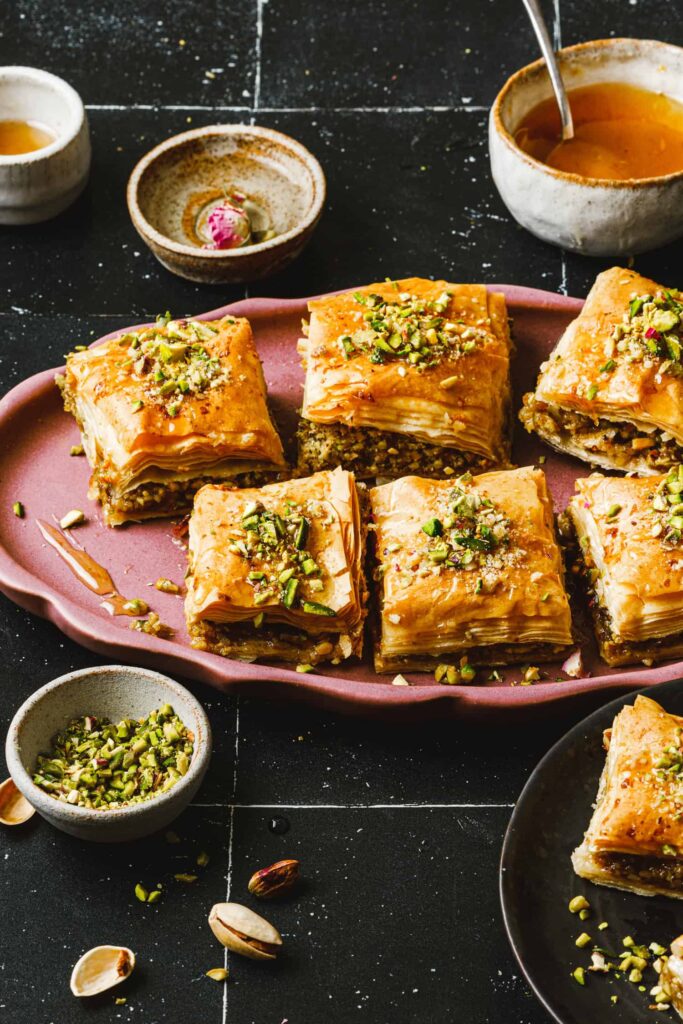
18) Baklava with Pistachios
Baklava with pistachios is a traditional Turkish dessert made with layers of thin phyllo dough. You fill those layers with chopped pistachios and butter. This combination creates a rich and flaky pastry.
Start by preheating your oven to 350°F. Melt some butter and brush it over a 9×13-inch baking dish. Trim your phyllo dough to fit the pan.
Place one sheet of phyllo dough in the baking dish and brush with melted butter. Repeat this process until you have several layers. Sprinkle a layer of finely chopped pistachios over the buttered phyllo.
Continue layering phyllo and butter, adding more pistachios after several layers. Once all the phyllo and pistachios are used, cut the baklava into small squares or diamonds before baking.
Bake in the preheated oven until golden and crispy. While the baklava cools, make a simple syrup by boiling sugar, water, and lemon juice. Pour the cooled syrup over the warm baklava and let it soak in.
Serve baklava at room temperature with coffee or tea.
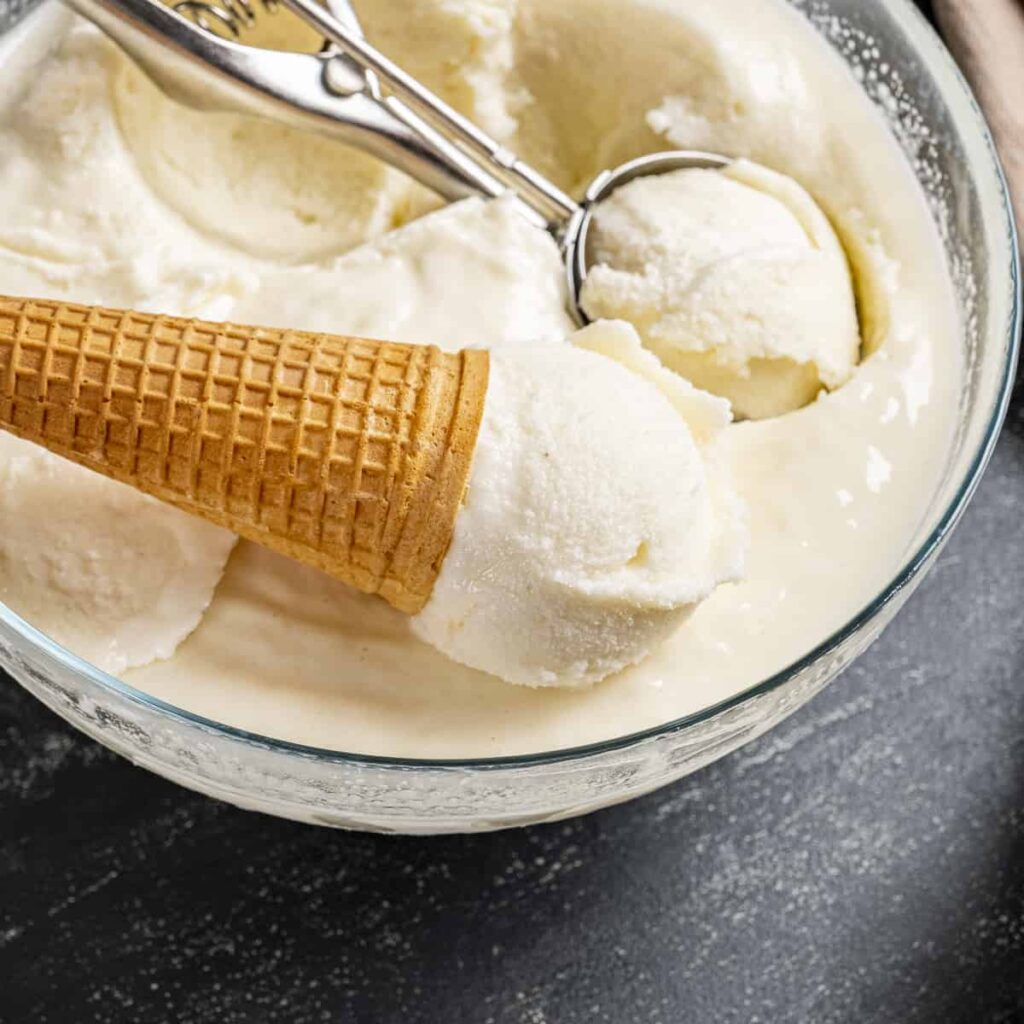
19) Dondurma (Turkish Ice Cream)
Dondurma is a unique Turkish ice cream that stands out with its stretchy and chewy texture. Unlike regular ice cream, it contains salep, a flour made from the tubers of wild orchids, which gives it its distinct consistency. Mastic, a resin, is also added for a subtle flavor and additional chewiness.
This ice cream is made using goat milk, which provides a richer taste compared to cow’s milk. The milk, sugar, and salep are combined and heated until the mixture thickens. Constant stirring is crucial to prevent burning and ensure a smooth texture.
One of the charming experiences of enjoying dondurma is watching the vendors. They use long-handled paddles to stretch and play with the ice cream, often teasing customers with playful tricks. This adds an element of entertainment to buying and eating dondurma.
You can find dondurma vendors in many Turkish cities, especially during the summer months. It’s a popular treat among locals and tourists alike. Traditionally, dondurma is served in a cone, but you can also enjoy it in a bowl.
Next time you visit Turkey, don’t miss the chance to try this delightful and entertaining dessert.
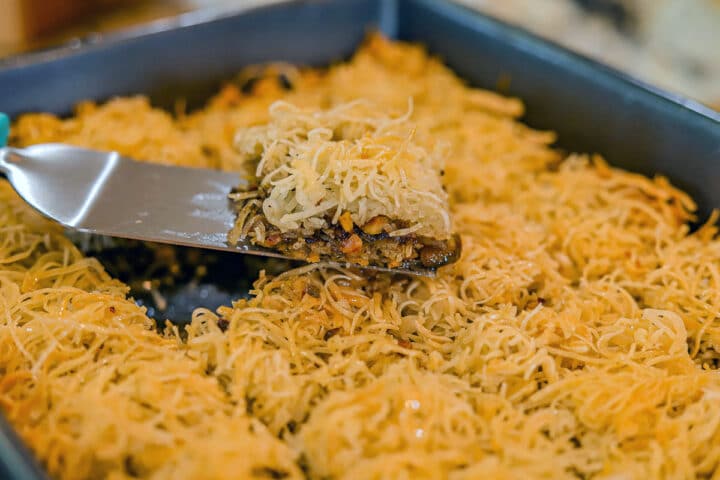
20) Kadayif
Kadayif is a traditional Turkish dessert known for its sweet flavor and crispy texture. It’s made from shredded filo dough, which you first cover with melted butter. This helps to give the dough its signature golden brown color and crunch when baked.
To prepare Kadayif, start by making a simple sugar syrup. Mix sugar and water in a pot, bring it to a boil, and let it simmer until it thickens. Add a bit of lemon juice to enhance the flavor and then let it cool.
For the main part of the dessert, layer half of the buttered kadayif in a greased baking tray. Press the dough down tightly to form a base. Sprinkle a layer of nuts, like pistachios or walnuts, over this base. Cover the nuts with the remaining kadayif, pressing down again.
Bake the layered kadayif in a preheated oven until it turns a beautiful golden brown. When it’s done baking, pour the cooled syrup evenly over the hot dessert. This allows the syrup to soak into the dough, making each bite sweet and delicious.
Let the Kadayif cool to room temperature before you slice it into squares. This dessert is best enjoyed when the syrup has fully soaked in, creating a delightful combination of crunchy and chewy textures.
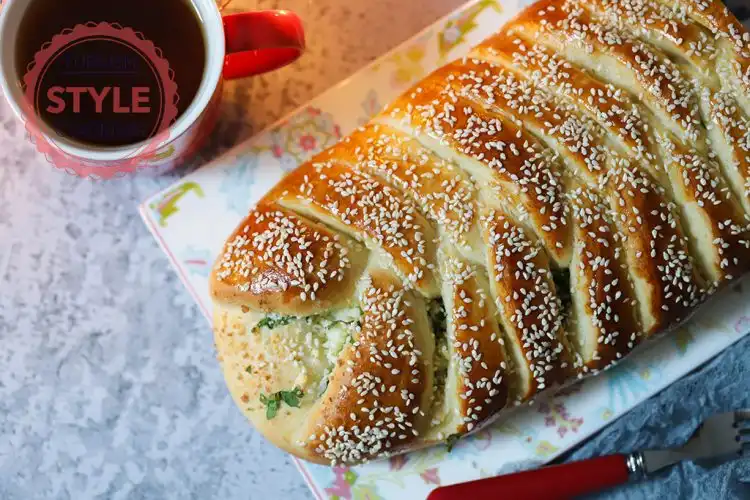
21) Çörek
Çörek is a traditional Turkish bread that you will love if you enjoy baked goods. It has a slightly sweet flavor and is soft on the inside while having a golden, crunchy crust on the outside.
The dough for çörek is made by mixing flour, sugar, instant yeast, warm milk, melted butter, an egg, and a pinch of salt. This mixture is kneaded until it becomes smooth and elastic. The dough needs to rest for a while to rise properly.
Once the dough has risen, it is shaped into round or braided loaves. These loaves are then brushed with egg wash to give them a shiny, golden finish when baked. Sometimes, sesame or nigella seeds are sprinkled on top for added flavor.
Çörek can be enjoyed as a part of breakfast, with a cup of tea, or as a snack. Its soft and fluffy texture makes it a favorite for many. When fresh out of the oven, the aroma is irresistible. You might find yourself eating more than one slice!
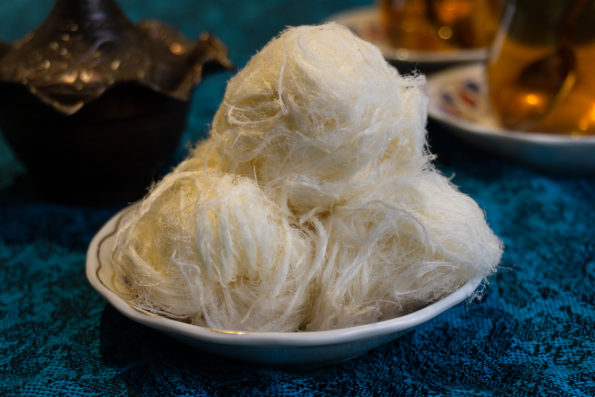
22) Pişmaniye
Pişmaniye, also known as Turkish cotton candy, is a traditional dessert that dates back to the 15th century. This dessert is similar to cotton candy but has a more nutty and buttery flavor.
To make pişmaniye, sugar syrup is boiled and then cooled on a marble slab. This forms a gummy texture. At the same time, flour and butter are roasted until lightly browned.
The cooled sugar is worked into a ring and pulled into widening loops. This is where pişmaniye gets its stringy, wool-like appearance. The process is repeated until the sugar forms fine strands.
Pişmaniye is sometimes called “fairy floss,” “string halva,” or “flax halva.” It’s light and fluffy, making it a popular treat at festivals and celebrations in Turkey.
The dessert is known by different names depending on the region. In Persian, it’s called “pashmak,” meaning it resembles sheep wool.
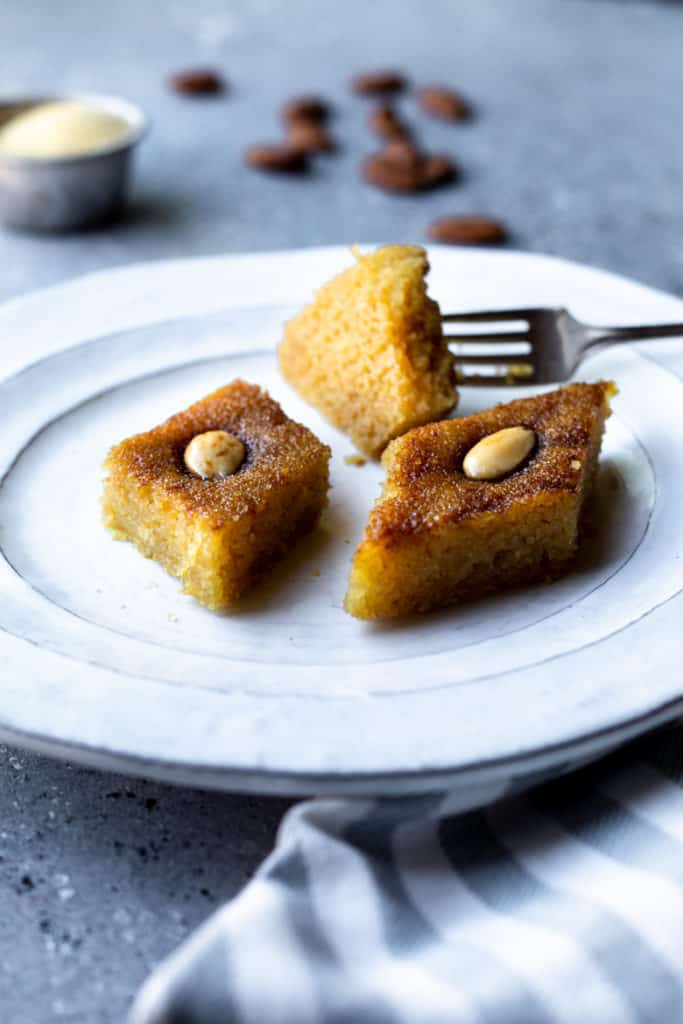
23) Şambali
Şambali is a traditional Turkish dessert from İzmir. It’s primarily made with semolina, sugar, and yogurt. Some recipes add coconut for extra flavor.
Once baked, Şambali is soaked in a sweet sugar syrup. This step gives the cake its signature moist texture.
In some variations, peanuts are placed on top before baking. This addition gives the dessert a crunchy twist.
The syrup is made by boiling water and sugar, then adding lemon juice. This tangy syrup balances the sweetness.
Şambali is similar to other Middle Eastern desserts like basbousa or revani. Yet, it stands out due to its unique ingredients and preparation.
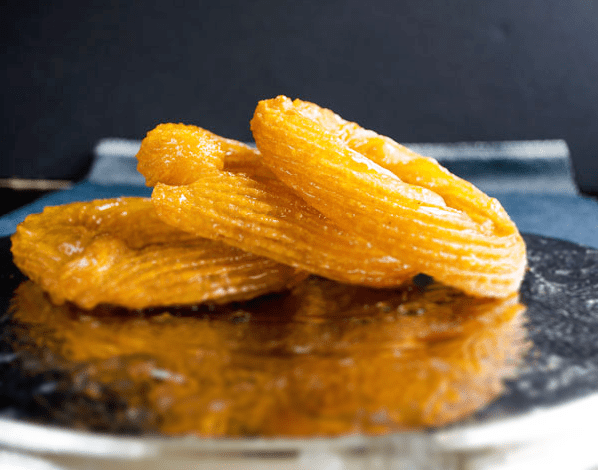
24) Halka Tatlısı
Halka Tatlısı is a popular Turkish dessert that you can find in many street food stalls across Turkey. Often referred to as Turkish churros, these sweet treats are shaped into rings.
To make Halka Tatlısı, you start by preparing a syrup. Boil sugar, water, and a slice of lemon until it becomes thick and syrupy. Then, let it cool.
For the dough, mix water and butter in a pot and bring it to a boil. Add flour, sugar, and salt, then stir until the mixture forms a non-stick dough. Remove it from heat and let it cool.
Once the dough is ready, pipe it into ring shapes and fry until golden brown. After frying, dip the Halka Tatlısı rings into the syrup, ensuring they are well-coated.
This dessert is crispy on the outside but soft and sweet on the inside. Halka Tatlısı is a delicious example of Turkish street food that you can easily make at home. Enjoy it fresh and warm for the best taste.
History and Cultural Significance
Turkish desserts are deeply rooted in history, showcasing the rich cultural heritage of the Ottoman Empire. They play a significant role in Turkish cuisine, often symbolizing hospitality and tradition.
Origins of Turkish Desserts
Turkish desserts have origins dating back to the Ottoman Empire. Notable examples include Turkish Delight (Lokum) and Baklava. Lokum emerged in the early 1700s, crafted by Bekir Effendi, and became a favorite among the Sultan and his court.
Baklava, another iconic dessert, has layers of thin pastry filled with nuts and sweetened with syrup. It highlights the intricate culinary skills developed over centuries. These desserts often use ingredients like rosewater, pistachios, and honey, reflecting the region’s rich agricultural history.
Role in Turkish Cuisine
In Turkish cuisine, desserts are more than just sweet treats. They are part of cultural rituals and celebrations. Ashure (Noah’s Pudding), often called the oldest dessert in the world, symbolizes sharing and community.
Tavuk Göğsü, a unique milk pudding made with chicken breast, showcases the creativity of Turkish chefs. Desserts like these are commonly offered to guests as a sign of hospitality. Whether celebrating religious festivals or family gatherings, these sweets play a crucial role in Turkish social life and culinary tradition.
Ingredients and Techniques
To create Turkish desserts, you need to understand both the essential ingredients and the traditional cooking methods. You’ll learn which ingredients give these sweets their unique flavors and textures, and how to use specific techniques to make them just right.
Essential Ingredients
Turkish desserts rely on a few key ingredients that give them their characteristic flavors. Phyllo dough is a staple for many desserts like baklava. This thin, flaky dough creates layers of crispness when baked.
Pistachios and walnuts are commonly used for their rich, nutty taste and crunchy texture. These nuts are often ground and layered between sheets of phyllo dough or added to fillings.
Honey and sugar syrups are vital for sweetness. They often get infused with citrus flavors, like lemon or orange, to add a tangy twist. For a creamy texture, milk and cream are frequently used, especially in puddings like muhallebi.
Rosewater and orange blossom water add floral notes to many sweets, offering a unique and delicate aroma. Butter is crucial for richness and helps bind ingredients together.
Traditional Cooking Methods
Making Turkish desserts involves several traditional techniques. For baklava, you must brush each layer of phyllo dough with melted butter before baking to get that perfect crispness.
Pistachio and walnut fillings are spread evenly to add crunch and flavor. After baking, a sugar or honey syrup is poured over the hot pastry to soak into the layers.
For puddings, like tavuk göğsü, you need to simmer milk and sugar mixtures slowly while constantly stirring to avoid lumps and achieve a smooth texture. Caramelization is another popular method used in desserts like kazandibi, where sugar is heated until it turns a rich, brown color to provide a deep, sweet flavor.
Baking at low temperatures for an extended period is essential for desserts that require a gentle setting, ensuring even cooking without burning. Slow simmering and precise temperature control are key to getting the right consistency and texture in many creamy desserts.
Layering ingredients and allowing them to meld flavors over time also help achieve the authentic taste that defines Turkish sweets.
Health Benefits and Nutritional Value
Many Turkish desserts offer not just delightful flavors but also some surprising health benefits. Understanding their nutritional content can help you make informed choices about enjoying these treats.
Nutritional Insights
Turkish desserts often use natural ingredients such as honey, nuts, and fruits, which add significant nutritional value. For example, baklava contains pistachios or walnuts, which are rich in healthy fats, protein, and dietary fiber.
Aşure or Noah’s Ark Pudding includes a variety of grains, nuts, and legumes. These ingredients provide a good source of vitamins, minerals, and antioxidants.
Fruit-based desserts, like quince and fig desserts, offer important nutrients like vitamin C and potassium, aiding in maintaining good health.
Health Impacts
While delicious, it’s important to enjoy Turkish desserts in moderation due to their sugar content. The syrups and sweeteners used can lead to high calorie intake if not eaten mindfully.
However, incorporating these desserts into a balanced diet can be beneficial. Nuts in desserts like baklava provide heart-healthy fats and can help in reducing cholesterol levels.
Fruits in desserts offer natural sugars along with fibers, which can be better for managing blood sugar levels compared to processed sweets. Eating these in small portions can add some nutritional diversity to your diet.
Modern Adaptations and Innovations
Many Turkish desserts have seen modern twists and creative modifications.
A popular example is chocolate baklava. This variation replaces traditional filling with rich chocolate.
Another innovation is vegan Turkish delight. Traditional recipes use gelatin, but modern versions use agar-agar.
Ice cream-filled kunefe is another exciting adaptation. The usual cheese filling is swapped with creamy ice cream.
Gluten-free versions of popular desserts like baklava and Turkish delight are now widely available. These options cater to dietary restrictions without compromising taste.
Fusion desserts have also become trendy. For instance, baklava cheesecake combines the flaky layers of baklava with creamy cheesecake.
For a unique twist, some chefs prepare matcha-flavored desserts. Matcha baklava is particularly popular, combining traditional ingredients with a hint of green tea.
Another trend is incorporating local fruits like figs and pomegranates into traditional desserts.
You might also come across sugar-free options. These use natural sweeteners such as honey or agave syrup.
Cold versions of traditionally warm desserts, like cold baklava, offer a refreshing take for hotter climates.
These modern adaptations and innovations keep Turkish desserts exciting and accessible to a wider audience.
